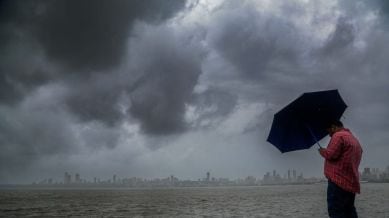Mumbai’s driest July since 2015; fails to meet monthly average quota

Amid an extended period of dry spell this month, the city’s Santacruz observatory failed to clock in even its average monsoon quota for July as the month ended on Thursday, receiving only 798 mm rain between July 1 and July 31. Data shows that this is Mumbai’s driest July since 2015, when the city had received only 359 rain in the month of July.
For the city’s Colaba station too, which also recorded deficit rainfall of 381 mm in July, this July has been its driest month in a decade, since 2015 when the station received 280 mm rain.
monthly limit of free stories.
with an Express account.
In the city, rainfall in the suburban district is gauged by the IMD’s recording station in Santacruz while the Colaba coastal observatory records the total rainfall in Mumbai’s city district. July, typically, is the city’s wettest month of the year when the suburban station clocks in an average of 856 mm rain, while the city division station records 734 mm rain.
However, this year, both stations failed to meet the average rainfall quota in July, in what has led to a rain deficit. Between July 1 and July 31, the Santacruz station received 798 mm rain, leading to a rain deficit of nearly 7 per cent from its actual average rain quota. Meanwhile, during the same period, the Colaba station recorded 381 mm rain, marking a negative departure of 48 per cent from its monthly actual average for July.
Data procured from the IMD shows that with the month ending in a rain deficit for both stations, this year, the month was the city’s driest July in a decade. Prior to this, the driest spell in July was observed in 2015 when the Santacruz station had received 359 mm rain whereas the Colaba station logged 280 mm rain.
Meteorologists have attributed the deficit to a long period of inactive monsoon phase where absence of active systems prevented strong monsoon currents. It was only in the latter half of the month between July 17 and July 26 when a low-pressure area formed over the Bay of Bengal, that the city received its maximum rainfall of the month. Yet, with the stations failing to accrue its actual average rainfall quota for the month, the Santacruz station is currently reeling under a deficit of 82 mm rain since June.
The record-breaking rain deficit in what is typically the city’s wettest month of the year has come along the Colaba division experiencing its wettest May month ever since 1918. Making for an anomalous monsoon season, Mumbai also witnessed its earliest monsoon onset since 1950 on May 26.
Spurred by the early onset, the Mumbai city district had logged excess rainfall of over 3025 per cent of its actual average rainfall for the season in May.
However, the month of June remained relatively drier with the Santacruz station logging a shortfall of nearly 5 per cent from its monthly average.
Despite the rain deficit in June and July, the water stock in the seven lakes catering to Mumbai’s potable water demands has continued to rise consistently. As of Thursday, the total stock in the lakes soared to 12.83 lakh million litres or 88.65 per cent of the total capacity, which is significantly higher than last year when the lake levels had remained at 77 per cent on the same day.
In 2023, meanwhile, the total water level had touched 76 per cent of the total capacity.